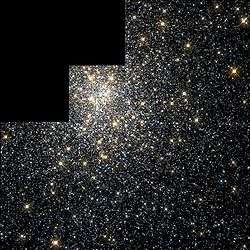< Messier Index

| Messier 28 | |
|---|---|
 Messier 28 by w:Hubble Space Telescope; 2.5′ view Credit: w:NASA/w:STScI/w:WikiSky | |
| Observation data (w:J2000 epoch) | |
| Class | IV |
| Constellation | Sagittarius |
| Right ascension | 18h 24m 32.89s[1] |
| Declination | -24° 52′ 11.4″[1] |
| Distance | 18.3 kly (5.6 kpc) |
| Apparent magnitude (V) | +7.66[1] |
| Apparent dimensions (V) | 11′.2 |
| Physical characteristics | |
| Mass | kg ( M) |
| Radius | 30 ly[2] |
| Notable features | Contains pulsar |
| Other designations | M 28, NGC 6626, GCl 94[1] |
Messier 28 (also known as M28 or NGC 6626) is a w:globular cluster in the w:constellation Sagittarius. It was discovered by w:Charles Messier in w:1764.
M28 is at a distance of about 18,000 to 19,000 w:light-years away from w:Earth. 18 RR Lyrae type w:variable stars have been observed in this cluster. In w:1986, M28 became the first globular cluster where a millisecond pulsar was discovered (by the w:Lovell Telescope at w:Jodrell Bank Observatory).[3]

Messier 28 on w:2MASS; wide angle
External links
References
- 1 2 3 4 "SIMBAD Astronomical Database". Results for NGC 6626. http://simbad.u-strasbg.fr/Simbad. Retrieved 2006-11-16.
- ↑ distance × sin( diameter_angle / 2 ) = 30 ly. radius
- ↑ "JBO - Stars". w:Jodrell Bank Observatory. http://www.jb.man.ac.uk/tech/lovell/aunstar.html. Retrieved 2007-06-01.
| |||||
This article is issued from
Wikibooks.
The text is licensed under Creative
Commons - Attribution - Sharealike.
Additional terms may apply for the media files.